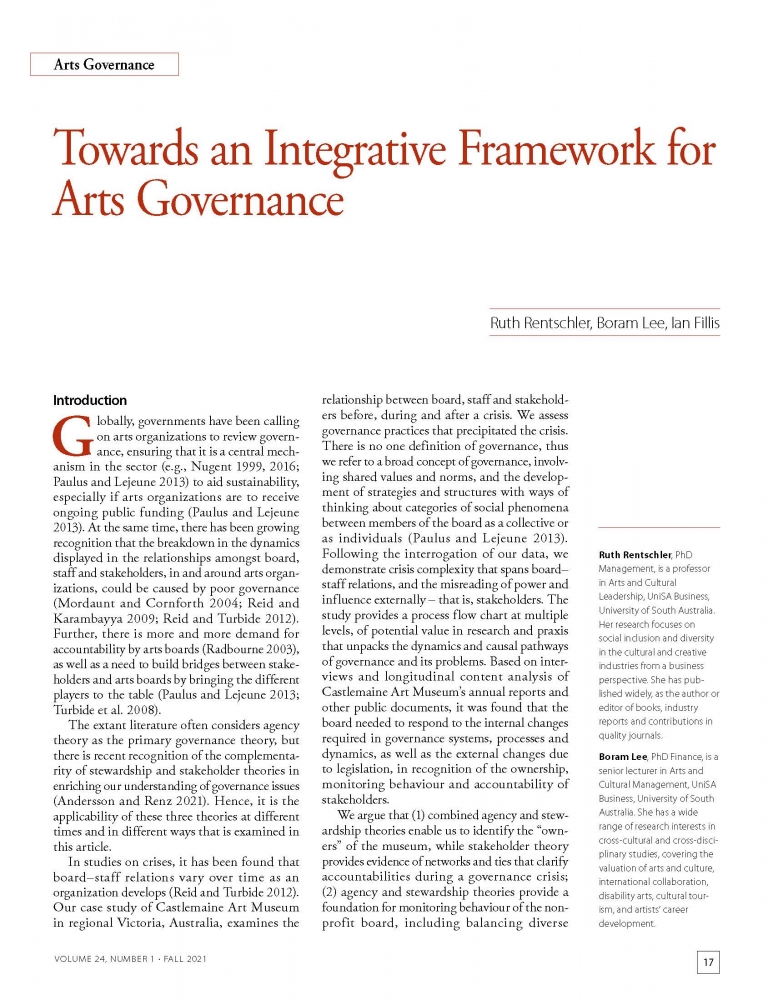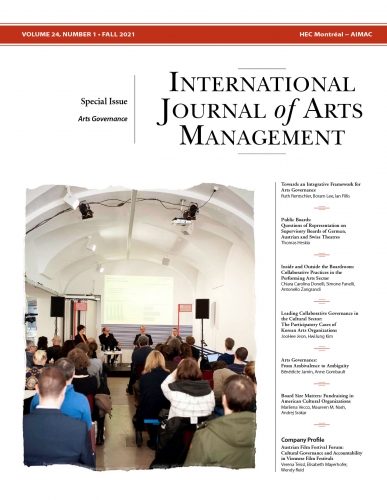Towards an Integrative Framework for Arts Governance
Product: Article
$21.00 CA
Ruth Rentschler, PhD Management, is a professor in Arts and Cultural Leadership, UniSA Business, University of South Australia. Her research focuses on social inclusion and diversity in the cultural and creative industries from a business perspective. She has published widely, as the author or editor of books, industry reports and contributions in quality journals.
Boram Lee, PhD Finance, is a senior lecturer in Arts and Cultural Management, UniSA Business, University of South Australia. She has a wide range of research interests in cross-cultural and cross-disciplinary studies, covering the valuation of arts and culture, international collaboration, disability arts, cultural tourism, and artists’ career development.
Ian Fillis, PhD, is a professor of Entrepreneurship, Liverpool Business School, Liverpool John Moores University, England. His research focuses on cultural entrepreneurship, small and medium-sized enterprise issues, and creativity. He has published over one hundred journal articles, as well as books and book chapters. He is the editor of the recently published Edward Elgar Handbook of Entrepreneurship and Marketing.
ABSTRACT:
The authors propose an integrative framework for examining arts governance in a domain that often has relied on singular perspectives. Complex phenomena require a framework that draws upon multiple theoretical lenses. In a longitudinal case study of a regional museum before, during and after a governance crisis, the authors integrate three governance theories – agency, stakeholder and stewardship – taking account of board, staff and stakeholder dynamics, in order to both frame the study and provide insight regarding critical incidents. The study reveals how the three theories interrelate and why none of them is a perfect explanation for a scenario, particularly in a crisis. The findings show that (1) governance theory integration may be a way forward in examining boards in crisis; (2) key board characteristics change at various stages in history, which affect community linkages, strategy, networking and resourcing; and (3) recognizing broader stakeholder ownership, monitoring behaviour, and stewardship offer the organization the best chance for survival. The complementary theories show how the museum has been governed, while also offering prescriptions for making non-profit boards more accountable to the community, with a greater role for stakeholder theory. A typology of governance theories and a longitudinal process flow chart of the unfolding of a crisis are included. The findings provide insights that may be helpful to non-profits grappling with governance in an uncertain and disrupted world.
RÉSUMÉ:
Cette étude utilise un cadre intégrateur afin d’analyser la gouvernance artistique dans un domaine qui, souvent, fait l’objet d’une approche unidimensionnelle. Les phénomènes complexes exigent des cadres qui s’appuient sur des perspectives théoriques multiples. Nous intégrons trois théories de la gouvernance – celles de l’agence, des parties prenantes et de l’intendance – prenant en compte la dynamique du conseil d’administration, du personnel ainsi que des parties prenantes; nous utilisons une étude de cas longitudinale d’un musée régional avant, pendant et après une crise de gouvernance, et ce, à la fois pour définir le contexte de l’étude et fournir une perspective en isolant des incidents critiques au fil du temps. L’étude expose comment ces trois théories sont liées et pourquoi aucune d’entre elles ne permet d’expliquer parfaitement une situation, en particulier en temps de crise. Ses conclusions permettent d’établir que : a) l’intégration des théories de la gouvernance peut être un moyen de faire évoluer l’analyse des conseils d’administration en crise ; b) les principales caractéristiques d’un conseil varient avec le temps, ce qui modifie les liens avec la communauté, les stratégies, le réseautage et les ressources ; et c) un engagement plus étendu des parties prenantes ainsi qu’une observation des comportements et de la gestion offrent au musée les meilleures chances de survie. Les théories complémentaires montrent comment le musée a été dirigé, tout en proposant diverses façons de rendre les conseils d’administration des organismes sans but non lucratif plus responsables à l’égard de la communauté dans son ensemble, notamment en accordant un plus grand rôle à la théorie des parties prenantes. L’étude fournit une typologie des théories de la gouvernance et un diagramme de flux des processus d’évolution d’une crise. Elle offre également une perspective qui pourrait être utile à d’autres organismes sans but lucratif aux prises avec des problèmes de gouvernance dans un monde incertain et perturbé.

